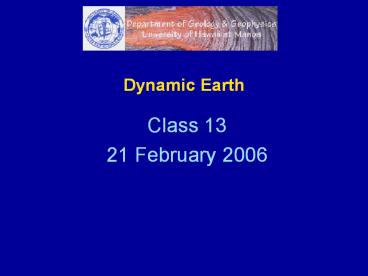Dynamic Earth - PowerPoint PPT Presentation
Title:
Dynamic Earth
Description:
Dynamic Earth – PowerPoint PPT presentation
Number of Views:28
Avg rating:3.0/5.0
Title: Dynamic Earth
1
Dynamic Earth
- Class 13
- 21 February 2006
2
Volcanic Imagination(Chapter 4,
continued)Exploring the Earths Interior
3
How do we know about the Earths Interior?
- Meteorites
- Direct observation
- High-pressure experimental petrology
- Earthquake waves (seismology)
4
Layers of the Earth
- Crust
- Rigid upper mantle (crust lithosphere)
- Asthenosphere
- Upper mantle
- Lower mantle
- Outer core
- Inner core
5
Earths internal heat
- Original heat
- Subsequent radioactive decay
- Conduction
- Convection
6
Crust as an Elastic Sheet
Continental ice loads the mantle
Ice causes isostatic subsidence
Melting of ice causes isostatic uplift
Return to isostatic equilibrium
7
The less dense crust floats on the less
buoyant, denser mantle
Mohorovicic Discontinuity (Moho)
8
Convection in Earths Mantle
- Convection happens when
- Temperature gradient exists
- Heat is directional
- Conduction operates slowly
- Surface area to depth ratio is low
- Viscosity of material not extremely high
9
Convection in Earths Mantle
- Assumptions
- Solid mantle behaves fluidly over time
- Mantle and core do not mix
- Heat generated from within the Earth
10
Temperature vs. Depth
11
Convection as a Possible Mechanism for Plate
Tectonics
12
Mantle Tomography
- Uses numerous seismic data
- Uses small changes in speed of seismic waves
- Faster wave motion may correspond to denser or
colder regions - Slower wave motion may correspond to buoyant or
warmer regions
13
Basics of Tomography
14
Tomography of the Mantle
15
Tomography at the Base of the Mantle
At 2770 km
16
Tomography Beneath Active Volcanoes
17
Tomography Beneath Active Volcanoes
18
Volcanic Activity on Earth
- Spreading centers (ridges)
- Island arc
- Hotspots
19
Hotspots
- Areas with volcanic activity NOT explained by
plate tectonics - Mantle beneath may be hot, wet, or chemically
different - Commonly active for long time
20
Global Hotspots
http//www.hvo.usgs.gov
21
Hotspot tracks
Flood basalts
Oceanic plateaus
22
Karoo / Etendeka Flood Basalts
23
Columbia River Flood Basalts
24
Linear Volcanic Chains
25
Hawaiian Islands - Emperor Seamounts
26
The trail of the Hawaiian Hot Spot goes all the
way to the far northwest Pacific
27
In addition to the Hawaiian Hot Spot track,
there are several others in the Pacific
28
(No Transcript)
29
(No Transcript)
30
Age Progressions Along Volcano Chains
31
Hawaiian Islands
Oldest
Youngest
32
Hotspot Observations
- Volcanic activity, NOT explained by plate
tectonics - Active for long time
- Age varies (youngest in opposite direction of
plate motion)
33
Hot spots are regions in the Asthenosphere that
are hotterthan their surroundings
34
Molten magma rises to the surface to form
volcanoes, similar to what happens at Spreading
Centers
35
Hot spot volcanoes are relatively small, isolated
features.
36
Hot spots are believed to be fixedrelative to
the mantle. BUT this is controversial!
37
When a plate moves over afixed Hot Spot, a
linear chain of volcanoes is formed.
38
Hotspot Origins - Mantle Plumes
39
Mantle plumes and eruption sizes
40
Convection in the Mantle
41
Convection and Mantle Plumes
42
Why Linear Chains of Volcanoes?
43
Model of Mantle Plumes
- A mantle plume rising beneath a slow-moving plate
or continent will puddle beneath the lithosphere
44
Model of Mantle Plumes
- When eruptions begin, they are voluminous,
causing oceanic plateaus and flood basalt
provinces
45
Model of Mantle Plumes
46
Model of Mantle Plume
47
Mantle Plume Shape Unknown
48
Model of Mantle Plumes
49
Models of Mantle Plumes
Wolfe et al., Nature, 1997
50
Tomography at the Base of the Mantle
At 2770 km
51
Instability Causes Mantle Plumes
52
How Can Plate Tectonics and Mantle Plumes Work
Together?
53
Why Are Hotspots Important
- Associated with Large Volcanic Eruptions
- May inject gas and particles into air
- May re-landscape large areas
- May decrease habitable areas
- May make life difficult for some plants and
animals (and cause mass extinction)
54
Volcanic Eruptions and the Atmosphere
55
Life on Earth is Difficult!
- Earthquakes
- Floods
- Climate changes (draught, ice ages)
- Other weather hazards (tornadoes, cyclones)
- Volcanic eruptions
- Meteor / asteroid impacts
56
Meteor / Asteroid Impacts
57
Meteor / Asteroid Impacts
58
Environmental Catastrophes and Hotspots
59
Extinction Percentages and Hotspots
60
Extinction is Forever
61
Thursday
- Video
- Death of the Dinosaurs































